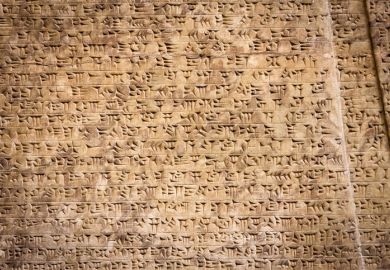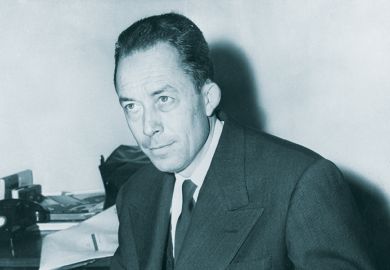Elisabeth Dutton finds a manifesto for poetry in a discussion of translation
Translation is always a reading as well as a writing; its material is less the meaning of a text than the translator's experience of that meaning; thus translation "involves self-study as much as it involves a reading of the other". Yves Bonnefoy, France's most esteemed living poet and its greatest translator of Shakespeare, asserts and embraces this potentially troubling truth towards the end of Shakespeare and the French Poet . The book's title is appropriate, as the reader may learn as much about Bonnefoy as about the Bard.
Shakespeare and the French Poet offers subjective readings of some of the plays that Bonnefoy has translated - Hamlet , Lear , The Winter's Tale , The Tempest , Julius Caesar , Antony and Cleopatra and Othello . While we may often sense that Bonnefoy has read a play aright, we may be troubled by his tendency to hide his evidence; when he offers it up he is compelling.
These critical essays were originally published as prefaces to Bonnefoy's translations of individual plays. Each essay develops in relation to what the editor John Naughton helpfully indicates to be the fundamental dialectic of Bonnefoy's poetics: the opposition between image and presence. Images are what we create from appearances, and alienate us from one another and the world. Images cause us to objectify people, to mistreat them in the name of emptied image-ideologies. By contrast, presence is created by love, an acceptance of "what is", particularly death, and, in the face of finitude, an act of will "to be". Thus Julius Caesar is primarily not political but "the study of the soul eternally torn between the intelligible and existence", like Hamlet . Prospero is a magus exposed as "withdrawn, and consequently without the power to... help life begin anew"; even his forgiveness is harsh, a function of the will to mastery, not an act of love. Perdita and Florizel emerge as heroes who will "set the truth of love against the bitter lessons of winter", as The Winter's Tale asserts the symbolic order, in which image and presence cohere over the empty image. The symbolic order is, Bonnefoy argues, a positive vestige of medieval mystery plays, and one that Shakespeare exposes as under threat from "Puritanism, dolorism, and the sexualisation of sin".
The only historicisation that Bonnefoy undertakes is in relation to Puritanism's attack on the theatre. This focus is justified by the few illuminating moments when Bonnefoy, who often self-consciously calls Shakespeare a poet, too, considers the relevance of Shakespeare's writing of drama. The stage, he notes, offered Shakespeare "all the possibilities of the spoken word", of characters who could give voice to "the stereotypical thinking of a society, its sexism for instance" but who could be juxtaposed with "more lucid intentions and even remarks of a subversive nature". Thus the poet writing for the theatre could "deepen his relation to... aspects of existence that are authentically real". In his sonnets, by contrast, he is trapped in the image-world by the "propensity towards the ideal" that loves a young man's beauty but undervalues ordinary reality, presence.
The collection may occasionally seem repetitious; but the reader has the option to read essays selectively. For all this we feel, with the translator, that "each new play brought its own problems"; tracing a common dialectical thread through the plays, we are struck afresh by the diversity of setting - of world-view, even - of the Shakespearean canon.
Bonnefoy's working, the process by which his discussions may be made convincing rather than seductive, is only occasionally shown in his essays on the plays. But this working is fully exposed in the second section of the book, a collection of essays and interviews in which Bonnefoy discusses the translator's art. Bonnefoy's authority as a critic comes from his activities as a translator. He writes of "pausing at every word" and "even sliding beneath a lot of them". His essays on translation continue the preoccupation with image and presence as it relates to the "opposing metaphysics" of the French and English languages: while English concerns itself naturally with the tangible, French encourages poets away from external reality to "a simplified, more circumscribed world" with "certain selected precepts".
From the problems of language difference, Bonnefoy moves to focus on the question of whether verse must be translated by verse (it must be) and expounds a manifesto for poetry, like Shakespeare's theatre, as "the war against conceptual representations". We can look to be well edified when the poet delivers the playwright.
Elisabeth Dutton is lecturer in medieval English, Oxford University.
Shakespeare and the French Poet
Author - Yves Bonnefoy
Publisher - University of Chicago Press
Pages - 283
Price - £38.50 and £16.00
ISBN - 0 226 06442 5 and 06443 3
Register to continue
Why register?
- Registration is free and only takes a moment
- Once registered, you can read 3 articles a month
- Sign up for our newsletter
Subscribe
Or subscribe for unlimited access to:
- Unlimited access to news, views, insights & reviews
- Digital editions
- Digital access to THE’s university and college rankings analysis
Already registered or a current subscriber? Login



